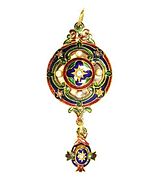John Brogden (2 November 1819 – 16 October 1884)[1] was a Victorian-era manufacturing jeweller.
Brogden was born in Islington, the son of Thomas and Ann Brogden.[2] In 1834, he was apprenticed for seven years to a London firm of watch and clockmakers, under master James William Garland, with a workshop in Bridgewater Square.[3] From 1842 to 1864, he was a partner in the firm of Watherston and Brogden (est. 1798), goldsmiths of 16 Henrietta Street, Covent Garden. In 1864 Brogden took over the business and operated under his own name until 1880. Between 1881 and 1885 he worked as an 'art goldsmith' at the Grand Hotel Buildings in Charing Cross.[4]
Besides exhibiting jewellery at the 1851 Great Exhibition, Brogden won awards at various exhibitions in Paris and London from the 1850s to the 1870s. His designs were inspired by archaeological and Renaissance objects and he enjoyed royal patronage.[5]
-
Gold cruciform pendant with a cameo of Christ's head wearing a crown of thorns, circa 1880, Birmingham Museum and Art Gallery
-
Phaethon cameo pendant set in a gold mount, circa 1880, Birmingham Museum and Art Gallery
-
Holbeinesque pendant, circa 1870
-
Reverse, with side initials "JB"
References
edit- ^ England & Wales, National Probate Calendar (Index of Wills and Administrations), 1858–1995
- ^ London, England, Church of England Births and Baptisms, 1813-1923
- ^ London, England, Freedom of the City Admission Papers, 1681–1930
- ^ Brogden family history
- ^ "Wartski". Archived from the original on 8 December 2007. Retrieved 4 June 2008.



